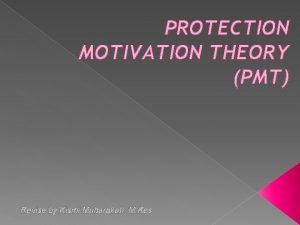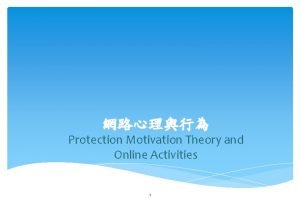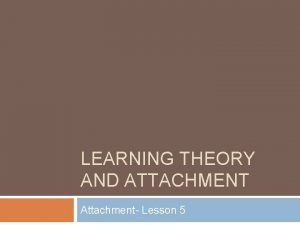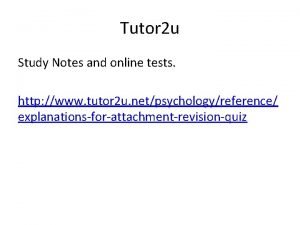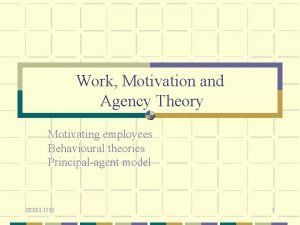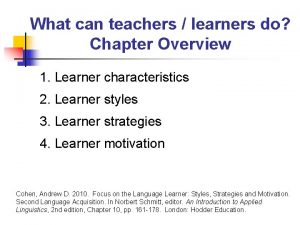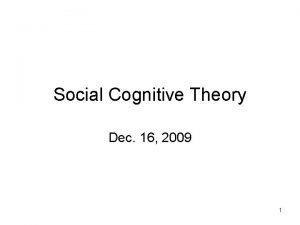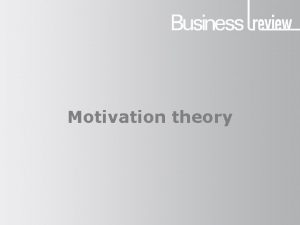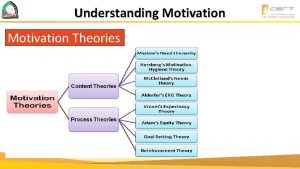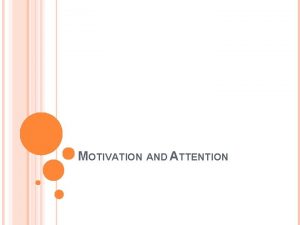Protection Motivation Theory and Online Activities 1 Outline




















- Slides: 20

網路心理與行為 Protection Motivation Theory and Online Activities 1

Outline Introduction Protection Motivation Theory Data Privacy Concerns Trust and Risk Perceptions Online Privacy Hypothesis Method Results Discussions 2


保護動機理論 Protection Motivation Theory (PMT; Rogers, 1975) identifies the cognitive processes that are used by an individual when they feel threatened, and puts forward a model for how people respond to these threats. PMT proposes that a person bases their assessment of threats on severity ad vulnerability. Once threat has been assessed, they base their evaluation of the perceived usefulness of potential responses to reduce threat. If actions are available that do not remove threat (maladapted responses), these are also evaluated and weighted, based on perceived rewards. 4

5

6


Trust and risk perception Consumer trust is heavily influenced by company reputation, website quality and baseline measures of disposition to trust. 8


研究主旨 本研究主要採用保護動機理論調查使用者線上威 脅的知覺以及相關的反應和自我效能的關係, 以 及這些關係是否會隨著不同的線上活動有所改變。 Specifically perceived threat severity, perceived vulnerability, perceived response efficacy and perceived self-efficacy were used to explore perception changes as the user shops, searches and uses social networking. 10

研究假說 H 1: Shopping online will have higher scores than search or social networking for perceived likelihood of financial loss. 和線上搜尋以及社交相比,線上購物有較高的財物損失 的自覺機率。 H 2: Shopping online will have lower scores than search or social networking for self-efficacy. 和線上搜尋以及社交相比,線上購物的活動有較低的自 我效能。 11

研究假說 H 3: Searching online will have lower scores than shopping or social networking for perceived likelihood of online data threats. 和線上購物以及社交相比,線上搜尋的活動有較低的威脅風險。 H 4: For all online activities, people with previous experience of information misuse will have higher scores for perceived likelihood of online threats. 對所有線上活動,有資訊誤用經驗的網友在自覺線上威脅機率 會高於沒有誤用經驗的網友。 12

研究假說 H 5: For all online activities, people with high self-perceived level of technological competence (SPTC) scores will have higher scores for self-efficacy. 對所有線上活動,自覺有較高技術能力的人也會有較高 的自我效能。 13







 Protection motivation theory
Protection motivation theory Protection motivation theory
Protection motivation theory 保護動機理論
保護動機理論 Theory x and theory y of motivation
Theory x and theory y of motivation Alfred kinsey ap psychology
Alfred kinsey ap psychology Both indoor and outdoor sports
Both indoor and outdoor sports Support activities and primary activities
Support activities and primary activities Primary activities and secondary activities
Primary activities and secondary activities Fall protection training outline
Fall protection training outline Sandwich statements
Sandwich statements Forefront online protection for exchange
Forefront online protection for exchange Exchange online protection overview
Exchange online protection overview The statement of cash flows helps users
The statement of cash flows helps users Maslow mcgregor
Maslow mcgregor Motivation theories
Motivation theories Learning theory attachment
Learning theory attachment Outline and evaluate bowlby's monotropic theory 8 marks
Outline and evaluate bowlby's monotropic theory 8 marks Agency theory of motivation
Agency theory of motivation Gardner's motivation theory
Gardner's motivation theory Social cognitive theory motivation
Social cognitive theory motivation Theories in organisational behaviour
Theories in organisational behaviour

